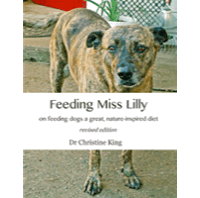Chapter 1: Dogs are Carnivores (excerpt)
When it comes to feeding dogs, perhaps the single most important thing to understand is that dogs are carnivores: they eat (in Latin: -vorare, to devour) animal flesh (carne-, flesh). They're not as strict about it as some other species, such as cats, but they are carnivores nonetheless.
Dogs are designed to eat other animals; not just muscle, but also the skin, bones, internal organs, and gut contents. That's their particular niche in the ecosystem, their assigned place in the web of life. I hated it when Miss Lilly killed other creatures, which she so loved to do, but it was natural to her. So, although I'm a long-time vegetarian myself (as I love to say, with mock horror, “I don't eat my patients!”), I fed Miss Lilly a meat-based diet.
Dogs are 'facultative' carnivores
Not all carnivores are created equal in their proclivities or nutritional requirements. Cats, for example, are described as 'obligate' carnivores, meaning that they are geared to rely solely on animal matter to meet all of their nutritional needs. In a word, they are obligated to eat other animals in order to thrive. In fact, they lack the digestive anatomy and physiology needed to make good use of much plant material.
Dogs are considered 'facultative' carnivores, meaning that they are true carnivores (flesh eaters), but they need not rely solely on animal matter to meet all of their nutritional needs. They can survive on other sources of food, such as plants and insects, for a time or as a supplement when meat is scarce.
Even so, it's important to understand that dogs are designed to get most of their nutritional needs from animal matter, not from plant matter.

Feeding Miss Lilly
on feeding dogs a great, nature-inspired diet
revised edition
Dr Christine King

PRINT EDITION
this button takes you to the book's page on Lulu.com
eBOOK EDITION
this button takes you to the e-book's page on Lulu.com
Chapter 1 (excerpt), read by the author